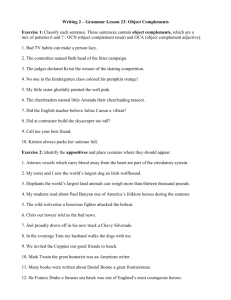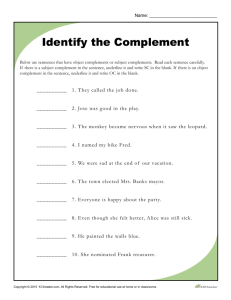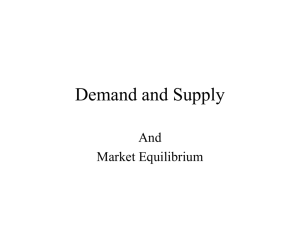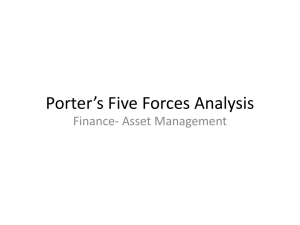What happens when markets are not in equilibrium
advertisement
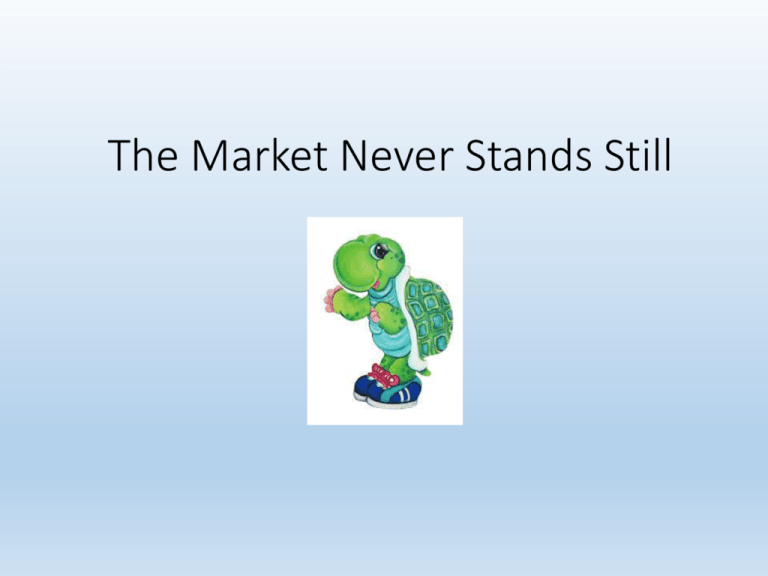
The Market Never Stands Still RIPEN and GRENT “Determinants of Supply and Demand” Please write down the three questions below. Use the chart on the next slide to answer. Thanks. 1. According to the schedule and the graph, what is the equilibrium price and quantity demanded in this example? 2. Priced at $19, what is the surplus / shortage? 3. If there is a shortage of -800, then what was the price of the DVDs? SSEMI3 The student will explain how markets, prices, and competition influence economic behavior. a. Identify and illustrate on a graph factors that cause changes in market supply and demand. b. Explain and illustrate on a graph how price floors create surpluses and price ceilings create shortages. c. Define price elasticity of demand and supply. Determinants of Demand • Change in consumer income • Change in tastes and preferences • Change in the price of a substitute good • Change in the price of a complementary good • Change in consumers’ price expectations • Change in number of consumers in the market Shifts in Demand 4.00 3.50 Demand price 3.00 2.50 A 2.00 B 1.50 C 1.00 D E 0.50 F D1 0.00 10 20 30 40 50 60 D2 70 Quantity of pecans per day 80 Determinants of Demand (from Cannon) (Things that shift the entire line!) •R •I elated goods (Complements and Substitutes) Complements: if price of complement increases, demand for the other good decreases; if price of the complement decreases, demand for the other good increases Substitutes: if price of substitute increases, demand for other good increases; if price of substitute decreases, demand for other good decreases ncome – income increases, demand increases; income decreases, demand decreases references – preferences increase, demand increases; preferences decrease, •P demand decreases xpectations – expect higher prices in future, current demand increases •E expect lower prices in future, current demand decreases •N umber of buyers – # of buyers increase, demand increases; # of buyers decrease, demand decreases Determinants of Demand (from Cannon) (Things that shift the entire line!) •R •I •P •E •N elated goods (Complements and Substitutes) Complements: if price of complement increases, demand for the other good decreases; if price of the complement decreases, demand for the other good increases Substitutes: if price of substitute increases, demand for other good increases; if price of substitute decreases, demand for other good decreases Related goods (Complements and Substitutes) Based on the law of demand, we know that when the price of a good rises, consumers will buy a smaller quantity of the good. Many goods have what economists call a complementary good. This is a good that is consumed with the original good. For example, peanut butter and jelly are often consumed together so they are called complementary goods. When the price of peanut butter rises, consumer respond by buying a smaller quantity of peanut butter. Since jelly is a complementary good to peanut butter, consumer buy less jelly at all prices, shifting the demand curve for jelly to the left. Determinants of Demand (from Cannon) (Things that shift the entire line!) •R •I elated goods (Complements and Substitutes) Complements: if price of complement increases, demand for the other good decreases; if price of the complement decreases, demand for the other good increases Substitutes: if price of substitute increases, demand for other good increases; if price of substitute decreases, demand for other good decreases ncome – income increases, demand increases; income decreases, demand decreases •P •E •N Income – income increases, demand increases; income decreases, demand decreases When a large number of consumers in the market for a good experience a change income, the entire demand curve in that market may shift. For example, if the United States is experiencing a severe recession, a large number of consumers in the market for automobiles will experience a decrease in income as companies reduce their work force. This will cause the demand curve for automobiles to decrease, shifting it to the left. In contrast, if the United States is experiencing a major period of economic growth, employers will have to compete with one another for workers and wages of consumers will rise. Therefore, the demand for automobiles will increase, shifting the demand to the right. Determinants of Demand (from Cannon) (Things that shift the entire line!) •R •I elated goods (Complements and Substitutes) Complements: if price of complement increases, demand for the other good decreases; if price of the complement decreases, demand for the other good increases Substitutes: if price of substitute increases, demand for other good increases; if price of substitute decreases, demand for other good decreases ncome – income increases, demand increases; income decreases, demand decreases references – preferences increase, demand increases; preferences decrease, •P demand decreases •E •N Preferences – preferences increase, demand increases; preferences decrease, demand decreases When a large number of consumers experience a change in preference toward or away from a good, the demand for the good will change. For example, as more information became available and marketing campaigns targeted the obesity problem in the United States, more and more consumers began to reject high fat, high calorie foods. This change caused a decrease in demand for many fast food items, shifting the demand for certain types of fast food to the left. Determinants of Demand (from Cannon) (Things that shift the entire line!) •R •I elated goods (Complements and Substitutes) Complements: if price of complement increases, demand for the other good decreases; if price of the complement decreases, demand for the other good increases Substitutes: if price of substitute increases, demand for other good increases; if price of substitute decreases, demand for other good decreases ncome – income increases, demand increases; income decreases, demand decreases references – preferences increase, demand increases; preferences decrease, •P demand decreases xpectations – expect higher prices in future, current demand increases •E expect lower prices in future, current demand decreases •N Expectations – expect higher prices in future, current demand increases expect lower prices in future, current demand decreases Sometimes, consumers predict that market prices for are going to change in the future. When consumers believe the price for a good will go lower in the future and they can delay their purchase until that time, the demand for the good will decrease now, shifting the demand curve to the left. If they believe prices will go up in the future, they will buy more of the good now before the price increase occurs, shifting the demand curve to the right. For example, during the Great Recession of 2008-2009, house prices in many markets around the United States fell drastically.. Consumers delayed their purchases because of an expected decrease in prices. Determinants of Demand (from Cannon) (Things that shift the entire line!) •R •I elated goods (Complements and Substitutes) Complements: if price of complement increases, demand for the other good decreases; if price of the complement decreases, demand for the other good increases Substitutes: if price of substitute increases, demand for other good increases; if price of substitute decreases, demand for other good decreases ncome – income increases, demand increases; income decreases, demand decreases references – preferences increase, demand increases; preferences decrease, •P demand decreases xpectations – expect higher prices in future, current demand increases •E expect lower prices in future, current demand decreases •N umber of buyers – # of buyers increase, demand increases; # of buyers decrease, demand decreases Number of buyers – # of buyers increase, demand increases; # of buyers decrease, demand decreases The demand for a particular good may increase or decrease due to more or less people in the market for the good. For example, before the advent of ecommerce (using the world wide web to buy and sell), most businesses sold products to people who lived in their area of the country or who ordered products from their mail order catalogs. As people began to use online shopping in greater numbers, many businesses with little or no web presence probably experienced a decline in consumers of their products due to increased competition from online businesses while businesses who quickly and effectively adapted to the ecommerce model probably saw an increase in consumers of their products. IRDL the Turtle!!!! Increase Right, Decrease Left Pecan Article • http://online.wsj.com/news/articles/SB100014240527487040768045 76180774248237738 Pecan statements 1. 2. 3. 4. 5. 6. 7. 8. Lunar New Year, Chinese love Pecans on New year Corn syrup, used with pecans to make pecan pie, has risen in price Price of walnuts increases Household income increases in China Price of pecans drops US trade agreements allow for more pecans to be sold in more countries Pecan prices expected to be higher next year Famous celebrities seen eating pecans at award ceremonies Determinants of Supply (from lesson) • Change in the cost of productive resources • Change in technology • Change in profit opportunities of producing other products • Change in producers’ price expectations • Change in number of sellers in the market • Change in the government tax or subsidy Determinants of Supply (from Cannon) •G overnment decisions •R esource prices or availability - TAXES – taxes increase, supply decreases; taxes decrease, supply increases SUBSIDIES –subsidies increase, supply increases; subsidies decrease, supply decreases REGULATIONS – regulations increase, supply decreases; regulations decrease, supply increases •resource prices have an inverse relationship with supply •resource availability has a direct relationship with supply •E xpectations – expect to sell more, supply increases; expect to sell less, •N umber of producers – direct relationship to supply •T echnology or training – direct relationship to supply supply decreases; expect to sell at future higher prices, immediate supply decreases. Shifts in Supply 4 3.5 S1 Supply price 3 S2 2.5 A 2 B 1.5 C 1 D E 0.5 F 0 10 20 30 40 50 60 Quantity of pecans per day 70 80 Pecan Statements (supply) 1. 2. 3. 4. 5. 6. 7. 8. US farmers cutting down pecan groves to make way for more profitable crops Price of pecan-shelling machines rises greatly Price of pecans falls as consumers prefer hazelnuts* Scientists successfully produce genetically modified pecan trees that can produce twice as much as a normal tree Engineers develop machines that “shake” the nuts out of trees US gov’t provides subsidies to pecan growers A flood destroys pecan groves in Georgia Pecan producers expect lower pecan prices due to declining demand for nuts Activity 6.3 & Cannon’s Activity
